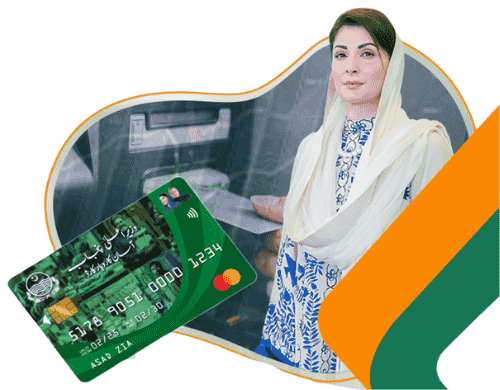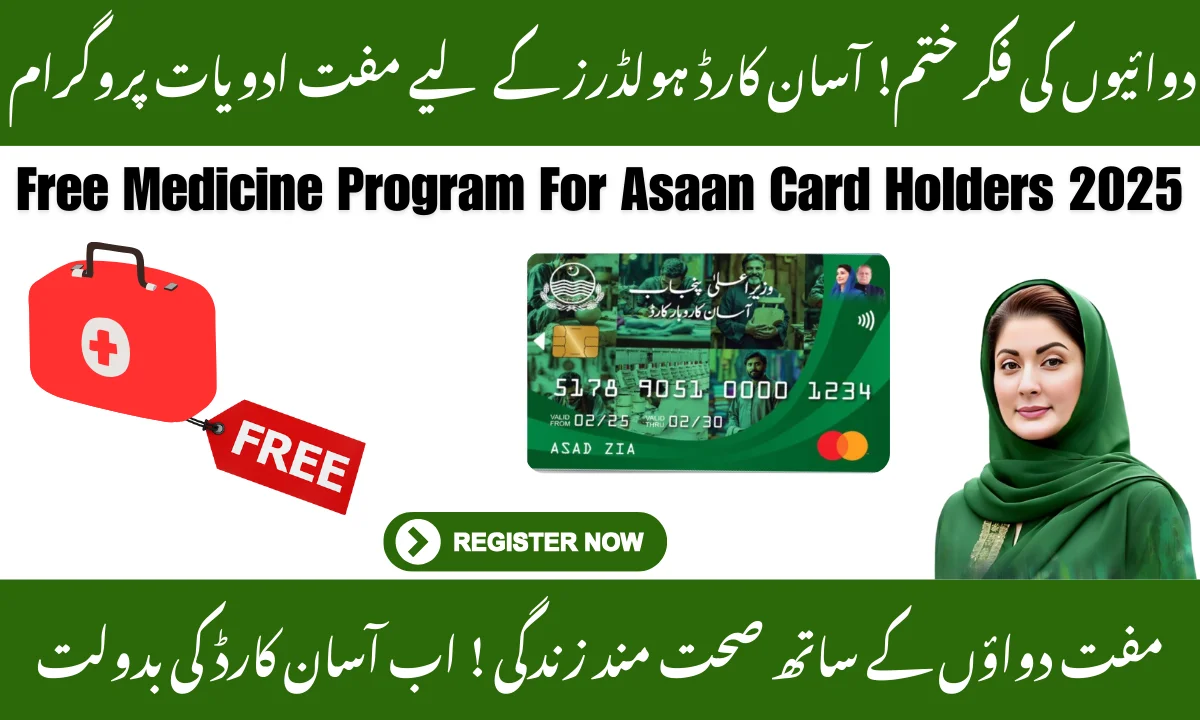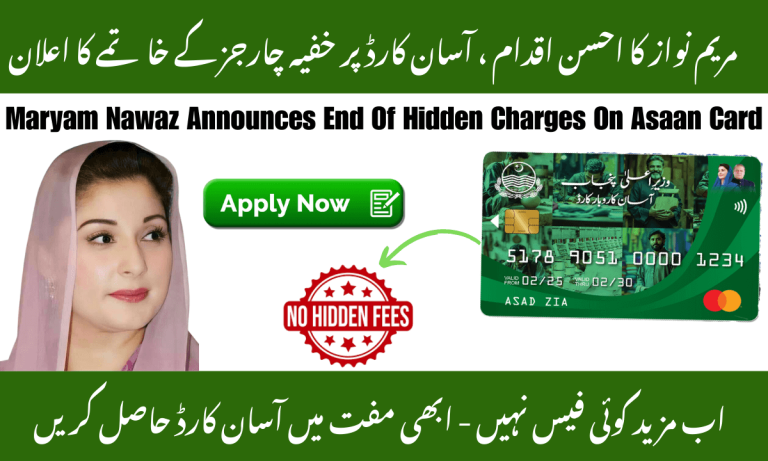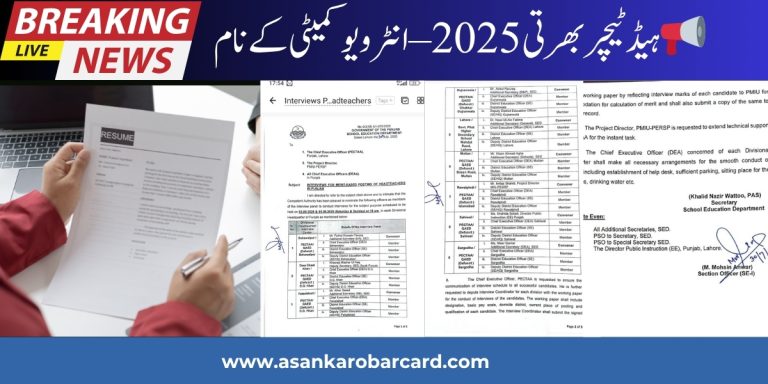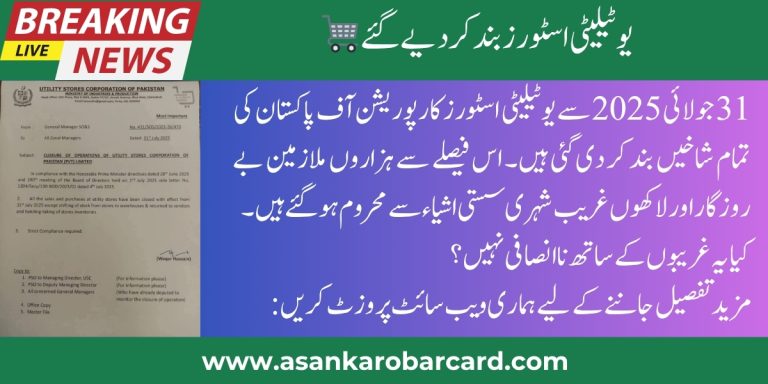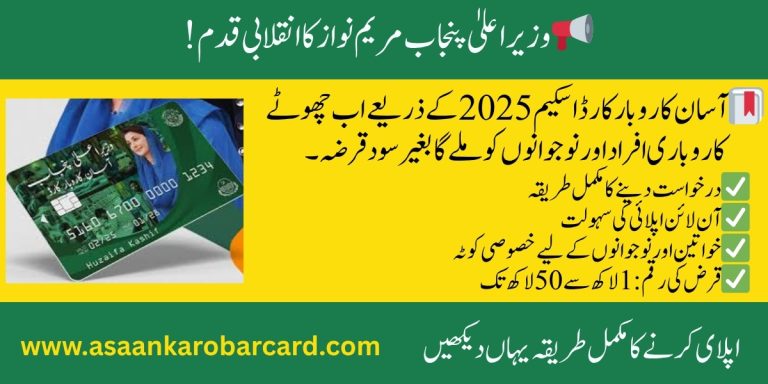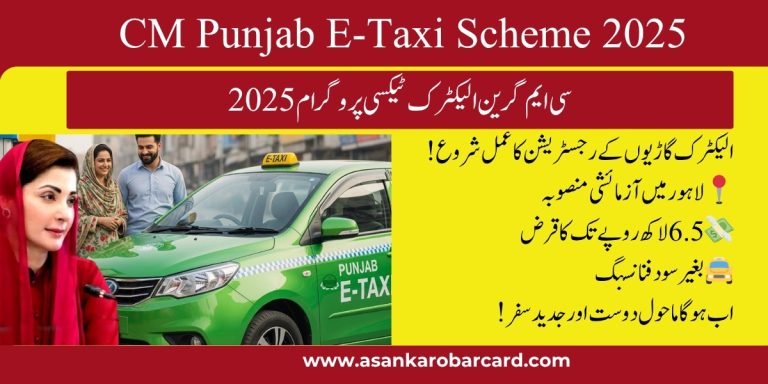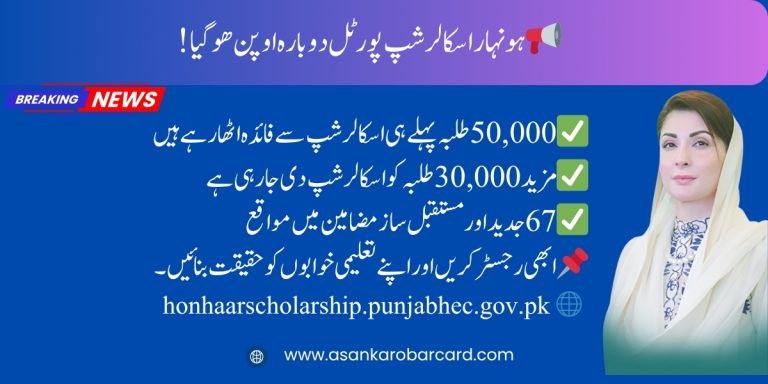Free Medicine Program for Asaan Card Holders Under Consideration 2025
The Free Medicine Program for Asaan Card Holders Under Consideration October 2025 has become a major topic of discussion in Pakistan. With rising healthcare costs and limited incomes, millions of families are hoping this initiative will ease their struggles. Medicines are among the most expensive necessities, and without government support, many patients simply cannot continue their treatments.
In October 2025, the government highlighted its strong focus on welfare and social protection by proposing the Free Medicine Program for Asaan Card Holders Under Consideration. This announcement has brought new hope to low-income families who already benefit from the Asaan Card scheme. If the plan is approved, deserving citizens will be able to access free or subsidized medicines through government hospitals and pharmacies.
The title itself reflects the urgency and importance of this welfare step. By connecting the Asaan Card with free medicine distribution, the government is making healthcare more affordable and transparent. This approach ensures that help reaches genuine cardholders, reducing their financial stress while improving public health outcomes across the country.
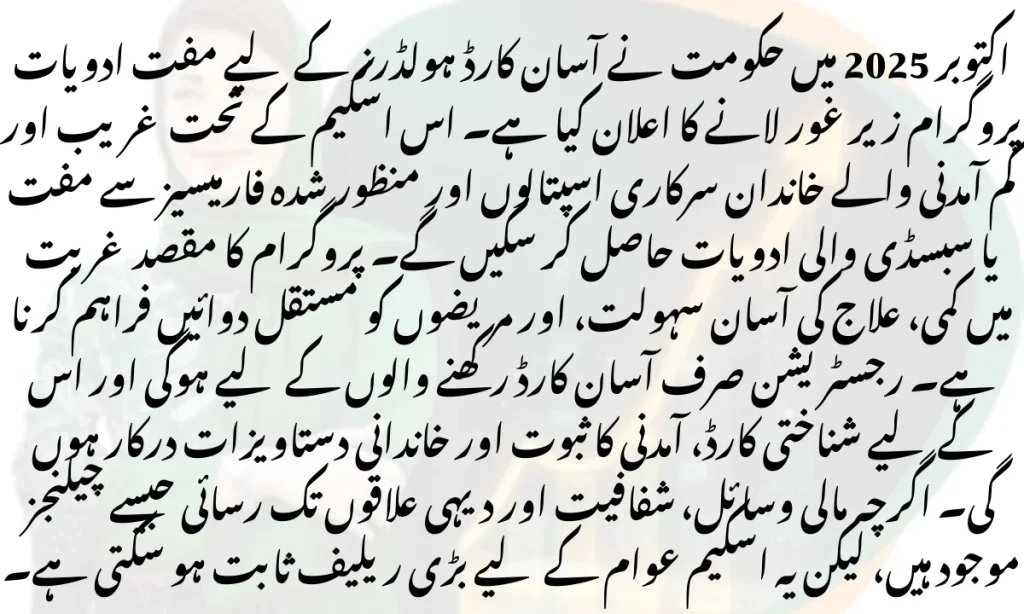
Key Highlights Features Of the Article
| Feature | Details |
|---|---|
| Program Name | Free Medicine Program for Asaan Card Holders |
| Status | Under Government Consideration |
| Announcement Time | October 2025 |
| Beneficiaries | Low-income families with Asaan Card |
| Benefits | Free / subsidized medicines at government hospitals |
| Authority | Ministry of Health Pakistan |
| Registration | Linked with Asaan Card registration |
| Required Documents | CNIC, Proof of Income, Family Details |
Background of the Asaan Card Program
The Asaan Card was introduced as part of the government’s broader poverty alleviation and welfare strategy. Its main purpose was to support low-income families by giving them access to subsidies, financial assistance, and opportunities for small businesses. Over time, the scheme has become an important social safety net. Families with Asaan Cards can already enjoy multiple benefits such as utility bill support, small business loans, and relief packages during emergencies.
Adding healthcare to this list of benefits would be a natural extension. Medicines are among the most unaffordable items for struggling households. By linking the Free Medicine Program with Asaan Cards, the government can ensure that help reaches exactly those who need it most.
Over the years, the government has used the Asaan Card as a platform to introduce various relief packages. From food subsidies during Ramadan to emergency cash support during natural disasters, the card has helped create a reliable identity-based welfare system. Millions of households depend on it, and extending its use to healthcare would only strengthen its role in the lives of struggling families.
The program also helps the government in maintaining accurate data on beneficiaries. Unlike older welfare systems where misuse was common, the Asaan Card is linked to NADRA records and biometric verification. This makes it easier to target the right people and ensure that the benefits reach genuine applicants without leakages or duplication.
The Need for a Free Medicine Program
The healthcare system in Pakistan faces serious challenges. According to surveys, a large percentage of people spend more than half their income on medical treatment. Chronic diseases such as diabetes, heart disease, blood pressure, and kidney problems require long-term medication, which many patients simply cannot afford.
In rural areas, the problem becomes even worse. Medicines are either unavailable, too expensive, or counterfeit. For families living hand-to-mouth, buying life-saving drugs is often out of reach. This is why the Free Medicine Program for Asaan Card Holders Under Consideration comes at the right time. It can bridge the gap between affordability and access.
Statistics show that nearly 60% of out-of-pocket healthcare spending in Pakistan goes toward purchasing medicines. For poor families, this expense can mean sacrificing other necessities such as education, food, or rent. Many patients are forced to skip doses or abandon treatment altogether, which worsens their conditions and eventually leads to higher medical costs.
Another key reason for such a program is the increasing burden of non-communicable diseases in the country. Heart problems, blood pressure, and diabetes are no longer limited to urban areas – they are widespread in rural communities too. Without affordable medicines, these illnesses often remain untreated until it is too late. Free medicine support under the Asaan Card can prevent such long-term suffering.
Government’s Consideration of the Program
In October 2025, discussions were held within the Ministry of Health Pakistan regarding this initiative. While still under review, the proposal suggests creating a supply chain of essential medicines through government hospitals and registered pharmacies. Distribution will be controlled through the digital Asaan Card system to prevent misuse.
If approved, the program is expected to roll out in phases, starting with major cities and then expanding to rural and remote areas. Officials are also considering collaborations with NGOs and private hospitals for wider coverage
Officials have also hinted at a pilot phase before the full launch. This would mean testing the program in selected districts to identify challenges in supply, verification, and distribution. Lessons from this pilot phase would then be applied to improve efficiency before rolling it out nationwide. This careful approach shows that the government wants to avoid past mistakes made in welfare projects.
Eligibility Criteria For Free Medicine Via Asaan Card
The Free Medicine Program for Asaan Card Holders Under Consideration – October 2025 is designed to help only those citizens who are genuinely struggling with healthcare costs. To make sure the right people benefit, the government has set certain eligibility conditions. These criteria ensure transparency and fairness in the selection process.
- Families already registered under the Asaan Card scheme.
- Households earning below a certain income threshold.
- Widows, disabled persons, and senior citizens.
- Patients with chronic diseases requiring continuous medication.
- Families living in rural or remote areas with limited healthcare access.
- Daily wage workers or unemployed individuals with verified low income.
- Single mothers or guardians taking care of dependents.
- Families already listed in poverty scorecard databases maintained by the government.
Required Documents
To prevent misuse and ensure that only eligible households get the benefits, specific documents will be required. These documents help verify the identity, income level, and medical needs of the applicant. The list below covers both basic identification and health-related proofs.
- CNIC (Computerized National Identity Card).
- Proof of income or poverty scorecard issued by government authorities.
- Family registration certificate (from NADRA).
- Asaan Card application or verification slip.
- Medical prescriptions (for chronic illnesses).
- Utility bills as proof of residence.
- Disability certificate (if applicable).
- Senior citizen card (for elderly applicants).
- Any supporting documents from hospitals confirming treatment requirements.
How to Apply for the Asaan Card – Few Steps Only
Since the program is linked to the Asaan Card, those who don’t yet have the card must first apply. The process is straightforward but requires proper documentation and verification. By following these steps carefully, applicants can ensure a smooth approval and avoid delays.
- Visit the official government portal or nearest facilitation center.
- Fill in the Asaan Card application form with family details.
- Submit CNIC, income certificate, and supporting documents.
- Provide a recent utility bill for address verification.
- Submit disability or medical certificates if applying under special categories.
- Wait for verification through NADRA and the poverty scorecard system.
- Receive SMS or official notification regarding approval status.
- Once approved, collect your Asaan Card from the designated distribution center.
- Use the card at hospitals and pharmacies once the Free Medicine Program officially launches.
Implementation Plan & Distribution Mechanism
The government plans to use a structured system to ensure fair distribution.
- Medicines will be provided through government hospitals, health centers, and selected pharmacies.
- Each transaction will be recorded digitally against the Asaan Card number.
- Biometric verification will reduce misuse.
- Supply chains will be monitored to prevent shortages.
Key Benefits of the Free Medicine Program
- Free access to life-saving drugs.
- Relief from high medical expenses.
- Better healthcare for low-income families.
- Support for chronic patients (diabetes, heart, kidney).
- Reduced financial stress for daily wage earners.
- Improved quality of life.
- Better maternal and child health.
- Reduced mortality due to untreated illnesses.
- Encouragement for preventive healthcare.
- More trust in government hospitals.
- Fair and transparent distribution through Asaan Card system.
- Better healthcare access for rural and remote areas.
- Reduction in counterfeit medicine purchases.
- Empowerment of women, elderly, and disabled.
- Overall improvement in public health and productivity.
Challenges and Concerns
Launching a large-scale healthcare scheme like the Free Medicine Program for Asaan Card Holders Under Consideration 2025 is not without its difficulties. While the program promises to bring major relief, several practical hurdles could delay or weaken its impact if not managed carefully. Understanding these challenges is important to set realistic expectations and ensure effective solutions.
- Budget allocation and financial sustainability.
- Risks of corruption or black-market sale of free medicines.
- Ensuring rural areas are not left behind.
- Continuous supply of quality medicines without shortages.
- Difficulty in monitoring distribution across thousands of centers.
- Limited digital literacy among beneficiaries for online verification.
- Possibility of political interference in beneficiary selection.
Role of Stakeholders
The success of the Free Medicine Program for Asaan Card Holders Under Consideration 2025 will depend on strong cooperation between multiple stakeholders. Since healthcare involves patients, providers, and regulators, each group has a vital role to play in ensuring fair, transparent, and smooth implementation.
- Government: Policy-making, funding, and implementation.
- NGOs & Welfare Organizations: Assisting in awareness and distribution.
- Healthcare Workers: Doctors and pharmacists ensuring proper prescriptions.
- Community: Reporting misuse and creating awareness.
- Media: Highlighting successes and exposing corruption to keep the program accountable.
- Private Sector: Pharmaceutical companies and pharmacies ensuring quality supply at reasonable rates.
- Academia & Researchers: Collecting data, analyzing impact, and suggesting improvements.
- Religious & Local Leaders: Encouraging community trust and participation in rural areas.

Conclusion
The Free Medicine Program for Asaan Card Holders Under Consideration is one of the most important welfare ideas discussed in October 2025. If implemented, it will not only reduce the burden of medical expenses but also save countless lives. Linking medicines with the Asaan Card system is a smart and transparent way to ensure only deserving families benefit.
For Pakistan, this program could be a turning point in public health policy. While challenges remain, the hope is that the government takes timely steps to make this vision a reality. After all, good health is not a luxury , it is a right every citizen deserves.
Frequently Asked Questions (FAQs)
Q1: What is the Free Medicine Program for Asaan Card Holders?
It is a proposed government scheme to provide free or subsidized medicines to low-income families who hold Asaan Cards.
Q2: When will the program start?
As of October 2025, the program is still under government consideration. Launch timelines will be announced after approval.
Q3: Who is eligible for the program?
Low-income families, widows, elderly, disabled individuals, and patients with chronic illnesses who are registered Asaan Card holders.
Q4: What documents are needed?
CNIC, proof of income, family details, Asaan Card, and valid medical prescriptions.
Q5: Where can cardholders get the medicines?
From government hospitals, health centers, and selected pharmacies linked with the program.
